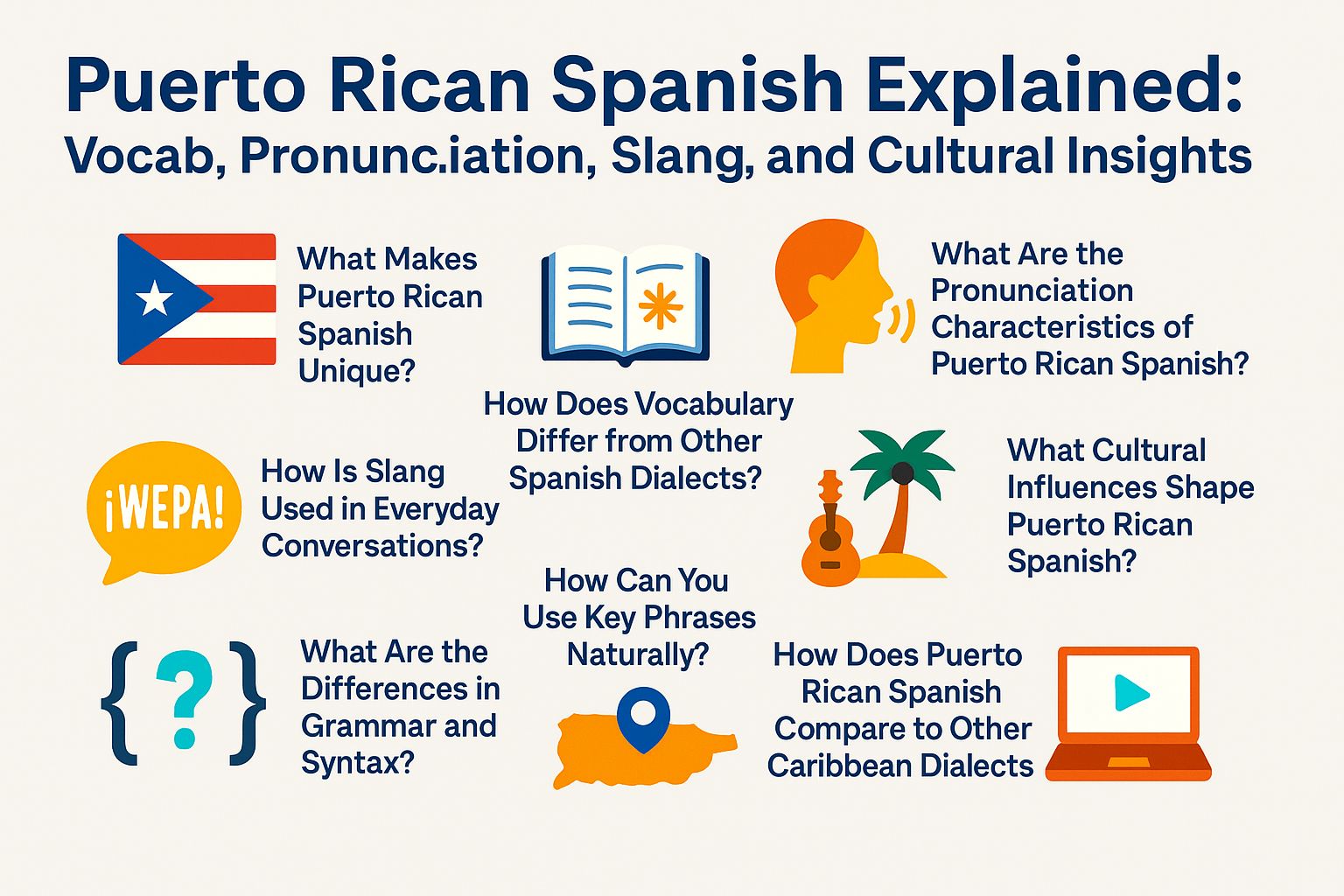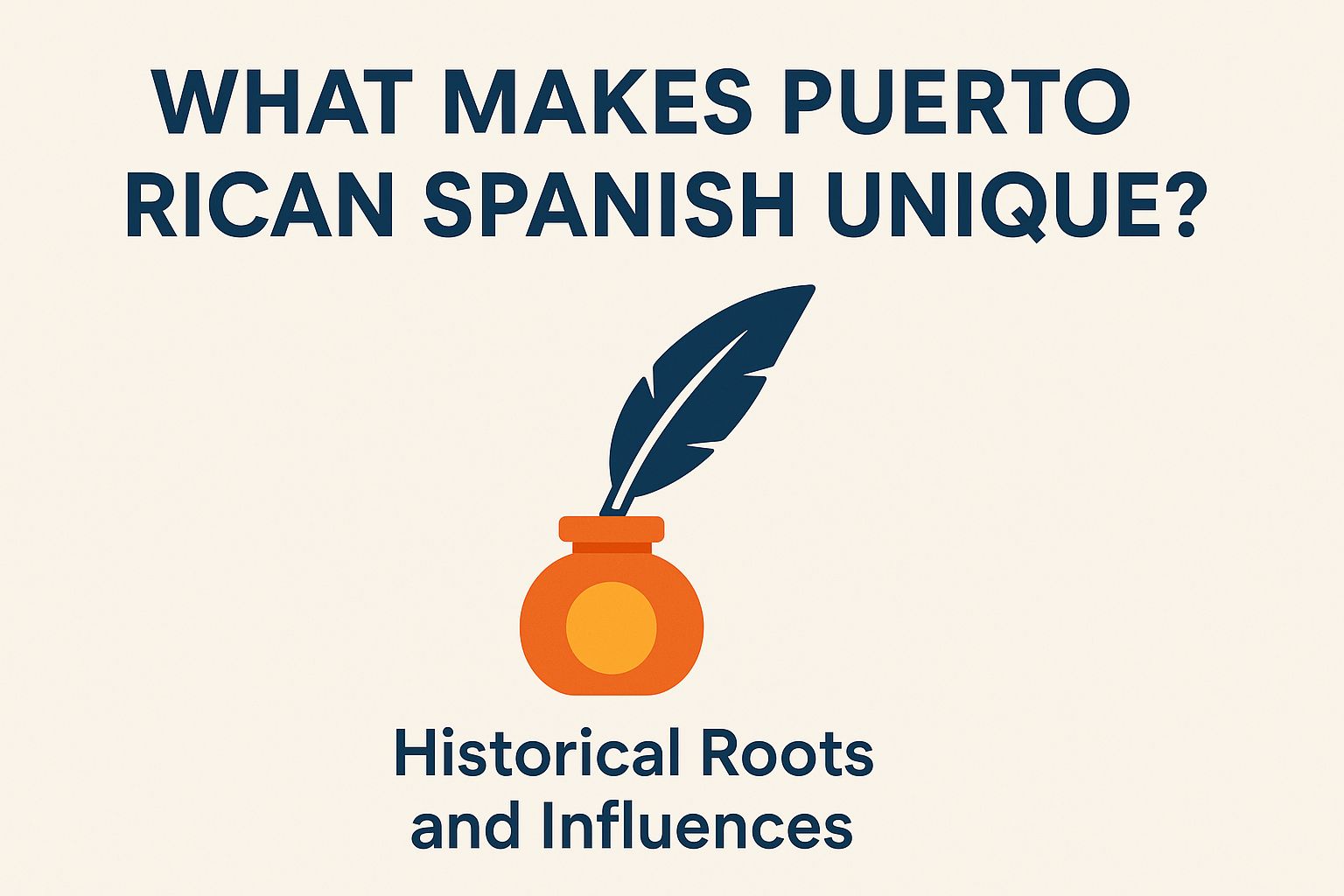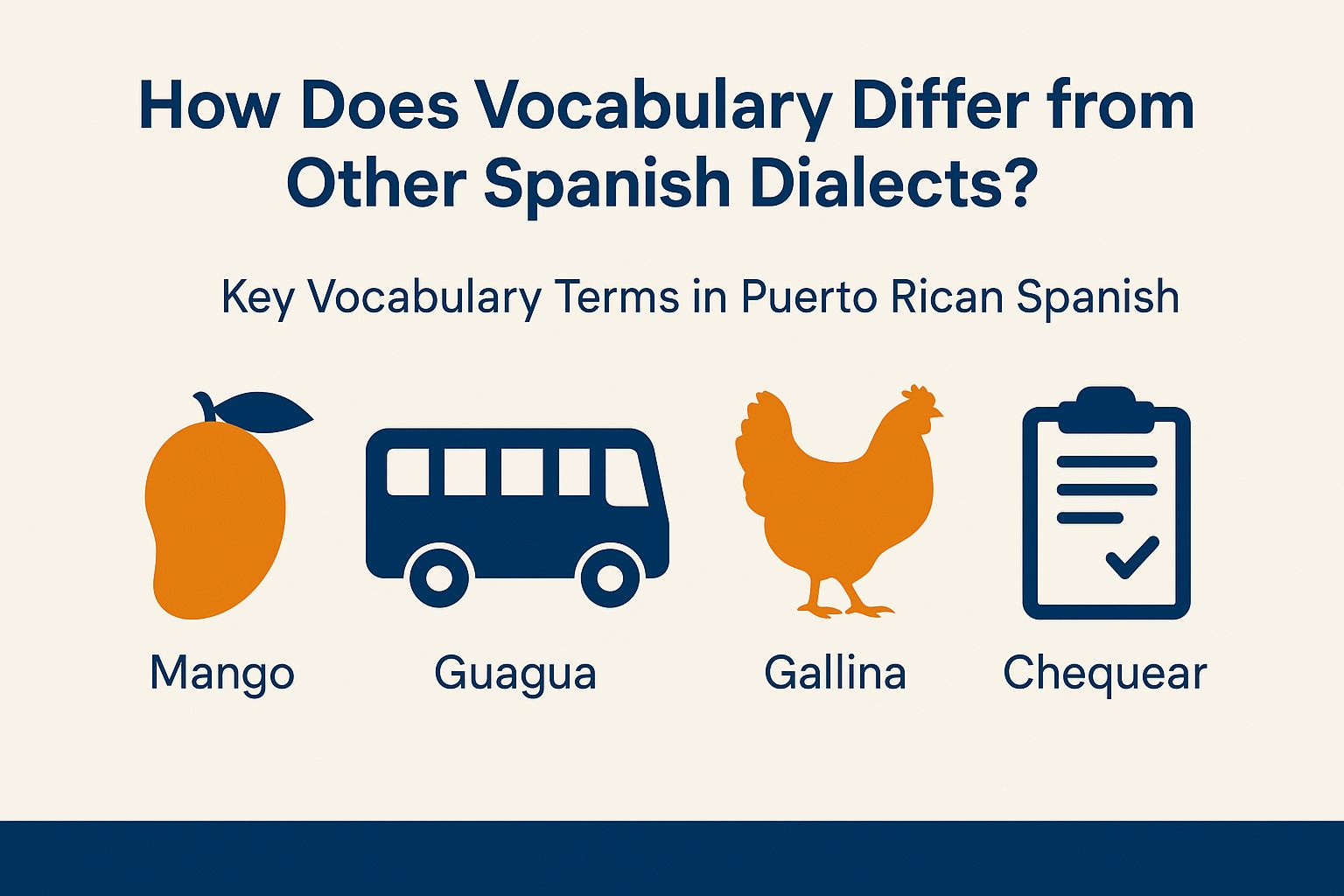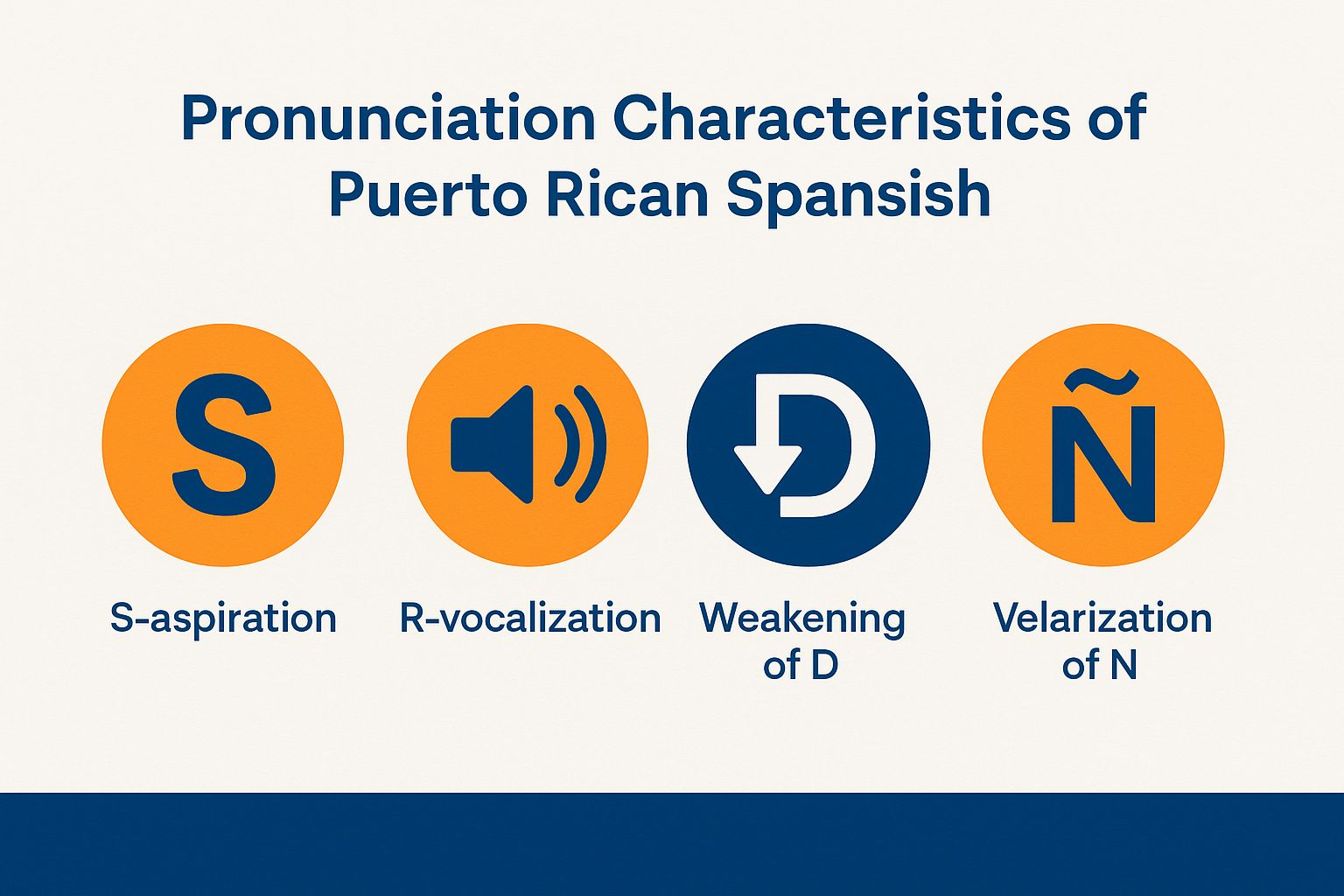
Curious about Puerto Rican Spanish? Discover this unique dialect.
You’ll uncover its rich roots and colorful slang that reflect Puerto Rico’s culture. This guide helps you grasp key phrases and pronunciation quirks. Connect with locals and appreciate the nuances of Puerto Rican Spanish.
Key Takeaways:Puerto Rican Spanish has a unique blend of historical roots, cultural influences, and vocabulary, making it distinct from other Spanish dialects.Key vocabulary and slang terms play a significant role in everyday conversations, adding color and depth to the language.To fully understand and use Puerto Rican Spanish, it’s essential to explore its cultural context, including music, food, and traditions.
What Makes Puerto Rican Spanish Unique?
Puerto Rican Spanish stands out among dialects. It has rich roots from Tano, African, and Spanish languages, plus English influences.

Historical Roots and Influences
The evolution of Puerto Rican Spanish is closely linked to the island’s colonial history, blending in elements from Tano and African languages along with various Spanish influences.
Starting from the late 15th century, Spanish colonization didn’t just bring new governance; it also introduced a whole new vocabulary. For instance, words like `batata’ (sweet potato) and `hammaca’ (hammock) come from Tano, giving you a glimpse into indigenous agricultural practices and the influence of Tano language.
There is African influence too. Terms like `bembe’ (festival) and `guaracha’ (fast-paced rhythm) show the blend of cultures.
This rich tapestry of language showcases Puerto Rico’s diverse heritage, highlighting how colonization shaped its unique identity through language and expression.
Vocabulary Differences in Spanish Dialects
Puerto Rican Spanish has a unique vocabulary that really makes it stand out from other Spanish dialects. You’ll find all sorts of special expressions and phrases that capture the local culture perfectly.

Key Vocabulary Terms in Puerto Rican Spanish
Understanding key vocabulary in Puerto Rican Spanish boosts your conversational skills and appreciation for the culture. To kickstart your vocabulary journey, here are some essential terms organized by theme.
- Food: Ever heard of `mofongo’? It’s a delicious dish made from fried plantains. And don’t forget about `pastelln,’ which is a tasty plantain casserole.
- Family: You might want to remember that `pana’ means buddy or friend, while `abuelita’ is a sweet way to say grandmother.
- Everyday Situations: When you’re out and about, `chinchorro’ refers to those casual roadside eateries you might stumble upon. And `coger’ can mean to take or catch a ride, so keep that in mind!
Learning these terms enhances your interactions and helps you connect with Puerto Rican culture.
Pronunciation Features of Puerto Rican Spanish
The way you pronounce Puerto Rican Spanish has some unique features that set it apart from other Spanish dialects.
You’ll notice that it’s often influenced by regional accents and phonological variations.

Common Pronunciation Variations
Puerto Rican Spanish has unique pronunciation. These differences help you communicate authentically.
For instance, the ‘s’ at the end of syllables often gets dropped. This makes ‘ms’ sound more like ‘m.’ You might also hear the ‘r’ getting softened, so ‘puerto’ sounds like ‘puertoo.’
Sometimes, you expect a softer ‘g’ sound, but it comes out harsher. For example, ‘digo’ may sound stronger.
To sharpen your skills, check out resources like the YouTube channel ‘SpanishPod101’ and the Duolingo app. They offer some targeted pronunciation exercises and examples that can really help you out.
Using Key Phrases Effectively
Using key phrases naturally is crucial for effective communication. Understand the local context and expressions.
When you get the hang of it, you’ll find that conversations flow much more smoothly and feel more genuine.

Examples of Everyday Conversations
Everyday conversations in Puerto Rican Spanish have unique phrases and expressions. For example, the greeting ‘Qu es la que hay?’ translates to ‘What’s going on?’ This captures the friendly vibe of Puerto Rican culture.
Another great example is “T sabe” (You know), which you can use for emphasis or to pull your listener into the conversation.
So, if someone says, “Me gusta el pltano, t sabe,” they’re not just sharing their preference; they’re also inviting you to connect and share in that understanding.
These phrases showcase the island’s warmth. They highlight how relationships matter more than just exchanging information.
Grammar and Syntax in Puerto Rican Spanish
Puerto Rican Spanish shares grammar rules with other dialects. However, there are interesting differences.
A key difference is Puerto Ricans often use “ustedes” instead of “vosotros.” You might hear “ustedes son” for “you all are.” This makes communication smoother.
Verb conjugations can also differ. For example, instead of “com” (I ate), you might hear “he comido” (I have eaten).
To understand these nuances, practice by chatting with native speakers or using platforms like italki, Baselang, or Preply.
Puerto Rican Spanish and Caribbean Dialects
Many resources help you explore Puerto Rican Spanish and its culture.
Cultural references are also important. Puerto Ricans sprinkle in phrases from salsa music and folklore, adding a special touch to their conversations.
By picking up on these nuances, you can improve your communication and deepen your appreciation for the different dialects.
Educational Resources for Learning Puerto Rican Spanish
There are plenty of resources out there to help you dive deeper into Puerto Rican Spanish and its cultural context. Check out these options to spice up your learning:
- italki: This platform connects you with native Puerto Rican tutors for personalized lessons, including tailored courses for Caribbean Spanish-speaking regions. Prices vary based on the tutor’s experience, so you can find one that fits your budget.
- Baselang: If you’re looking for immersion, this service offers unlimited Spanish tutoring for a monthly fee, perfect for enhancing your Puerto Rican Spanish skills. It’s a fantastic way to get in some serious language practice.
- SpanishPod101: This podcast series has lessons specifically focused on Puerto Rican Spanish, helping you pick up on the nuances through listening and understanding cultural sayings.
- YouTube Channel – Learn Spanish with Sabine: Her engaging videos showcase expressions that are unique to Puerto Rico, making learning fun and diving into Puerto Rican culture.
- Blog – Puerto Rican Spanish: This site features articles on language variations and cultural insights that will deepen your understanding.
Using these resources can really boost your fluency and comprehension.
Common Misconceptions About Puerto Rican Spanish
There are quite a few misconceptions about Puerto Rican Spanish that can lead to misunderstandings about the dialect and its speakers. For example, one common myth is that Puerto Rican Spanish is just “broken Spanish.” In reality, it boasts unique phonetics and syntax that come from Spanish, African languages, and Tano influences, making it rich and diverse.
Another myth is that Puerto Ricans speak English instead of Spanish. While English is official, Spanish is used in daily life.
If you want to dive into this vibrant dialect, immerse yourself in Puerto Rican media. Listen to local podcasts or chat with native speakers on platforms like Preply and blogs by Olly Richards.Doing this will not only broaden your understanding but also deepen your appreciation for the cultural nuances.
Frequently Asked Questions
What makes Puerto Rican Spanish different from other Spanish dialects like Andalusian Spanish?
Puerto Rican Spanish is a unique dialect that has been influenced by various cultures, including indigenous Tano, Spanish colonizers, and African slaves. This blend of influences has resulted in a distinct vocabulary, pronunciation, and slang that sets it apart from other Spanish dialects.
What are some examples of unique vocabulary in Puerto Rican Spanish?
Puerto Rican Spanish includes words that are not commonly used in other Spanish-speaking countries. For example, instead of saying “ustedes” for “you all,” Puerto Ricans say “ustedes” or “ustedes dos.” Other notable words include “guagua” for “bus,” “fiao” for “credit,” and “chavos” for “money.”
Pronunciation in Puerto Rican Spanish
One of the most distinct features of Puerto Rican Spanish is its pronunciation. For instance, the “r” sound is often pronounced as a soft “l.” This makes words like “carro” sound like “callo.” Additionally, the “s” sound is often dropped at the end of words. So, “despus” becomes “despu.”
Popular Slang in Puerto Rican Spanish
Slang is an integral part of Puerto Rican Spanish, and it’s constantly evolving. Some common slang terms include “qu tal?” for “what’s up?”, “chvere” for “cool,” and “guayarse” for “to tease.” Some slang terms may have different meanings in other Spanish-speaking countries, so it’s best to ask for clarification when in doubt.
Cultural Influence on the Language
The Puerto Rican culture heavily influences the language, as seen in the use of indigenous words, African-inspired rhythms, and Spanish customs. It’s also common to hear English words mixed into conversations, reflecting the American influence on the island.
Tips for Using Puerto Rican Spanish
To use Puerto Rican Spanish phrases naturally, it’s essential to practice listening and speaking with native speakers. Pay attention to the intonation, rhythm, and slang used in casual conversations. Don’t be afraid to ask for clarification or to repeat a phrase if you don’t understand it the first time. With time and practice, you’ll be speaking Puerto Rican Spanish like a pro!